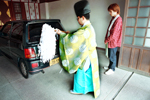Covering
Japan: Nagasaki Journal |
The Students
The Classes
Worrisome
Rise in School Dropouts
Pressure, Boredom, Fear Prompt ‘Refusers’ to Stop Going to
Class; Many End Up in Low-Paying Jobs
By Jessi Hempel
Special to the Mercury News
(This story originally appeared in the San Jose Mercury
News on August 8, 2002. Click here
to view it on the Mercury News web site)
NAGASAKI, Japan – Miyuki Tominaga dropped out of elementary school
five years ago when she was 12. Her grades weren't bad, and she liked
her teachers. But she developed a rash on her arms, and her classmates
started picking on her.
"Mostly the boys," she said. "But eventually everyone did.
I was so nervous I would get stomachaches and fevers."
 Miyuki Tominaga, 17, right, who dropped out of school at age 12, joins other futoko at the less structured Nagasaki Free Space. |
At first she started missing days of
school, then weeks. Eventually she stopped going altogether. For more
than a year she stayed home, confined to her bedroom. Finally, she enrolled
in night school.
Miyuki is a futoko – a refuser. She is one of the growing ranks
of Japanese students who avoid school for a variety of reasons, from boredom
to pressures to conform to fear of teachers or students. Across Japan,
education officials say, 26,000 elementary and 106,000 junior high students
refuse to go to school. In Nagasaki, one in 33 junior high students dropped
out in 2000.
It's a trend that has Japanese officials and parents worried. During the
past 25 years, the nation's dropout rate has risen tenfold, and it's been
shown that once students leave the system, it's nearly impossible to reintegrate
them. Most will end up in low-paying service jobs; a small number will
simply stay home and live out the rest of their lives with their parents.
Teachers agree that some of their brightest students may be opting out
of the school system. The futoko represent a cross section of Nagasaki's
430,000 residents, said Kazuko Igata, who since 1989 has worked with refusers
at a program called Nagasaki Free Space.
This leads many parents and teachers to look for the source of this problem
within an aging, rigid curriculum that values conformity over students'
individual needs.
"Japanese schools emphasize the importance of cohesion," said
Kaname Okada, a sixth-grade teacher in Nagasaki. "It's more important
in Japanese culture to keep students with the group."
"These kids are not bad kids," Okada said of the refusers. "They're
often the smart kids. Some of them are afraid of getting picked on for
being too smart."
In Nagasaki, every child in sixth grade learns the same lesson at the
same time. Junior-high students wear uniforms, and dress is strictly regulated
from hairstyles to shoe colors. Aside from programs for children with
severe disabilities, there is no special support for children who struggle
with their work or learn more quickly.
That is why Yukie Wakasa believes her son Kunihiro left his junior high
three years ago. "Schools don't allow for individuality," she
said. "Kunihiro is an amazing kid who likes to do things by himself."
Wakasa's younger son, Yoshiuki, also left school at 13 after he began
vomiting and having diarrhea. She said everyone in her family was embarrassed
and ashamed. And Yoshiuki said he used to hide in the car and pretend
he was sleeping rather than accompany his mother into stores because he
did not want to run into former classmates.
Many people who work with these children say this sense of shame is pervasive
and may prevent the children from getting the help they need once they
leave school. Some families say they worry they have failed their children
by providing poor discipline. Many teachers say they feel they have failed
because they cannot figure out what these children need to do to succeed
in the classroom.
Officially, the Board of Education offers a special school to help refusers
return. But many children complain about its structure. "There was
a teacher who lectured and rows of desks," said Misato Nagata, 17.
"It was too much like regular school and I hated it."
So Misato began attending Nagasaki Free Space instead. Started 13 years
ago as a monthly support group for families, it now holds weekly meetings
for kids as well.
"It's a transit place," Igata said of the small room that hosts
a dozen young people each Thursday afternoon. "They come to get revived
and they leave rested. We show them that it is OK for them to be exactly
who they are."
At Free Space, Misato hangs out with other children as well as their mothers
and several volunteers. Activities are not organized, but children play
the piano, use the computer and play cards. There is no instruction unless
it is initiated by the children – a controversial element of the
program.
This type of program is popular among school refusers because it does
not encourage children to return to traditional schools. Many go to night
school, a four-year version of Japan's traditional three-year high school
that teaches the same material at a slower pace. Others, such as the Wakasa
brothers, study at home through correspondence programs.
Educators are wary about acknowledging this growing phenomenon. At the
school where Okada teaches, he said, "teachers know there is a problem,
but no one there is doing anything."
When school refusers turn 15, principals normally award them graduation
certificates regardless of whether they complete their studies. And once
children have fallen off the traditional education path, they are left
to navigate new territory in the job world.
That's if they can work at all. Education professor Katsuyuki Hiroki said
many refusers become reclusive as adults and can't leave their bedrooms.
Hiroki said 1 million adults suffer from this affliction, called hikikomori.
At the other end of the spectrum, some refusers have decided to tune back
in. They are taking the Japanese high-school equivalency exam and even
winning admission to universities.
"Some become teachers and counselors," Hiroki said. "I
know of one refuser who is studying to be a lawyer."

